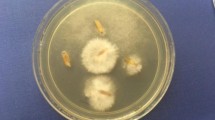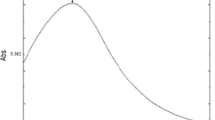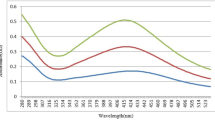Abstract
In India more than 60 % of the population relies on crops for their livelihood. However, crop diseases are one of the major factors limiting productivity. Hence, nanotechnology appears as a new means to control diseases and enhance yield. Here, stable copper nanoparticles were synthesized using cetyl trimethyl ammonium bromide and copper nitrate at room temperature, then characterized by UV–Visible spectrophotometry, X-ray diffraction, Fourier transform infrared spectroscopy, transmission electron microscopy and zeta potential measurement. The antifungal activity was evaluated against three common crop pathogenic Fusarium spp. We found that stable copper nanoparticles synthesized using 0.030 M cetyl trimethyl ammonium bromide and 0.003 M copper nitrate have the maximum activity against Fusarium equiseti with a 25 mm zone of inhibition, followed by F. oxysporum (20 mm) and F. culmorum (19 mm).




Similar content being viewed by others
References
Bahadory M (2008) Synthesis of noble metal nanoparticles. Ph. D thesis, pp 86–153
Booth C, Waterson JM (1964) Fusarium culmorum. CMI descriptions of pathogenic Fungi and Bacteria No. 26. Commonwealth Agricultural Bureaux. 2
Bottalico A (1998) Fusarium diseases of cereals: species complex and related mycotoxin profiles in Europe. J Plant Pathol 80(29):85–103
Clear RM, Patrick SK (2000) Fusarium head blight pathogens isolated from Fusarium damaged kernels of wheat in western Canada, 1993 to 1998. Can J Plant Pathol 22:51–60
CLSI (2002) Reference method for broth dilution antifungal susceptibility testing of filamentous fungi; approved standard. CLSI document M38-A. CLSI, Pennsylvania. ISBN 1-56238-470-8
Gittard SD, Hojo D, Hyde GK, Scarel G, Narayan RJ, Parsons GN (2010) Antifungal textiles formed using silver deposition in supercritical carbon dioxide. J Mater Eng Perform 19:368–373
Hobbelen PH, Paveley ND, Van Den Bosch F (2014) The emergence of resistance to fungicides. PLoS One 9(3):e91910
Hu X, Yuan X, Dong L (2014) Coal fly ash and straw immobilize Cu, Cd and Zn from mining waste land. Environ Chem Lett 12:289–295. doi:10.1007/s10311-013-0441-3
Jang KD, Ortega A, Ucol J, Du H, Kim NS (2012) Effect of lithium ions on copper nanoparticle size, shape, and distribution. J Nanotechnol 2012:1–6. doi:10.1155/2012/469834
Kanhed P, Birla S, Gaikwad S, Gade A et al (2014) In vitro antifungal efficacy of copper nanoparticles against selected crop pathogenic fungi. Mater Lett 115:13–17
Kasiri MB, Safapour S (2014) Natural dyes and antimicrobials for green treatment of textiles. Environ Chem Lett 12:1–13. doi:10.1007/s10311-013-0426-2
Lee H, Park SH, Seo S-G, Kim S-J, Kim S-C, Park Y-K, Jung S-C (2014) Preparation and characterization of copper nanoparticles via the liquid phase plasma method. Curr Nanosci 10:7–10
Magdassi S, Grouchko M, Kamyshny A (2010) Copper nanoparticles for printed electronics: routes towards achieving oxidation stability. Materials 3:4626–4638. doi:10.3390/ma3094626
Mahamadi C, Zambara P (2013) High Cu removal from water using water hyacinth fixed on alginate. Environ Chem Lett 11:377–383. doi:10.1007/s10311-013-0418-2
Mesterhazy A, Bartók T, Kászonyi G, Varga M, Tóth B, Varga J (2005) Common resistance to different Fusarium spp. causing Fusarium head blight in wheat. Eur J Plant Pathol 112:267–281
Mousavi SR, Rezaei M (2011) Nanotechnology in agriculture and food production. J Appl Environ Biol Sci 1(10):414–419
Prom LK, Horsley RD, Steffenson BJ, Schwarz PB (1999) Development of Fusarium head blight and accumulation of deoxynivalenol in barley sampled at different growth stages. J Am Soc Brew Chem 57(2):60–63
Raabe RD, Conners IL, Martinez AP (1981) Checklist of plant diseases in Hawaii: including records of microorganisms, principally fungi, found in the states. Hawaii Institute of Tropical Agriculture and Human Resources (CTAHR), information text series 022
Ramyadevi J, Jeyasubramanian K, Marikani A, Rajakumar G, Rahuman AA (2012) Synthesis and antimicrobial activity of copper nanoparticles. Mater Lett 71:114–116
Shah AT, Ahmad S, Kashif M, Khan MF, Shahzad K, Tabassum S, Mujahid A (2014) In situ synthesis of copper nanoparticles on SBA-16 silica spheres. Arab J Chem. doi:10.1016/j.arabjc.2014.02.013
Singh HP, Mahajan P, Kaur S, Batish DR, Kohli RK (2013) Chromium toxicity and tolerance in plants. Environ Chem Lett 11:229–254. doi:10.1007/s10311-013-0407-5
Warzecha T, Lundh D, Mandal A (2011) Effect of Fusarium culmorum infection on survivability of a T-DNA tagged mutant of Arabidopsis thaliana harboring a mutation in the peptide transporter gene At5g46050. J Biotechnol Comput Biol Bionanotechnol 92(1):77–84
Zhang X, Cui Z (2009) Synthesis of Cu nanowires via solventhermal reduction in reverse microemulsion system. J Phys Confer Ser 152:012022. doi:10.1088/1742-6596/152/1/012022
Acknowledgments
The authors are thankful to University Grants commission, New Delhi for financial support under UGC-SAP.
Author information
Authors and Affiliations
Corresponding author
Rights and permissions
About this article
Cite this article
Bramhanwade, K., Shende, S., Bonde, S. et al. Fungicidal activity of Cu nanoparticles against Fusarium causing crop diseases. Environ Chem Lett 14, 229–235 (2016). https://doi.org/10.1007/s10311-015-0543-1
Received:
Accepted:
Published:
Issue Date:
DOI: https://doi.org/10.1007/s10311-015-0543-1




